The cedar rook of Cheops: 5 long journey 000 years
And now we turn to a very interesting stories.
26 May 1954 for the Egyptians was most likely an ordinary hot day, when everyone was busy with his own business, and someone, on the contrary, had a rest from these very things. But this day has become a landmark for historians around the world. During the archaeological excavations under numerous layers of stones, sand and limestone, a unique object was discovered that is directly related to the history of ancient Egypt - the Solar ship of Cheops.
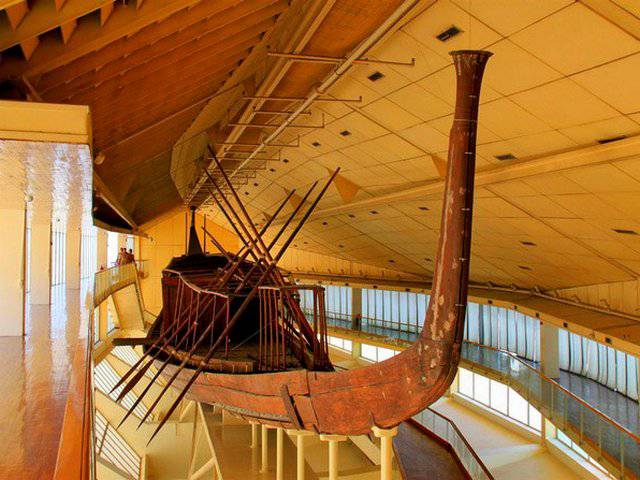
"Solar boat" - view from the nose.
How did this happen? Everything is very simple. The Second World War ended and the Egyptian government decided to put in order some of the pyramids that were near Cairo. Near the Giza is located the majestic complex of pyramids, which includes the pyramid of Cheops - the largest of the pyramids of Egypt.
It all began with an archaeological expedition working near neighboring tombs. A team of hired workers, cleaning the sides of the pyramid from dirt and sand, worked hard. Working hard, they dumped the excavated land at the foot of the Great Pyramid.
"Solar boat" - a view from the stern.
Finally, only the southern side remains untreated from the ground. In spite of the fact that the earth heap was already elevated by such a heap about 20 meters in height, the workers did not have the right to use the equipment, as they risked catching and God forbid destroying something valuable and unique. Spatulas, hoes, brushes - that’s the whole set of tools that could be used with great care in excavations.
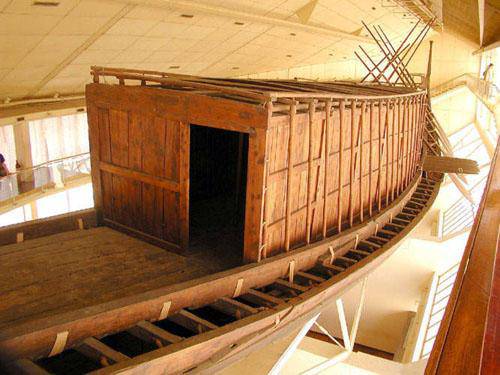
View of the middle part and the "cabin".
Continuing the excavation further, archaeologists discovered a number of carefully hewn blocks of sandstone. The width of the row was about 5 meters, and the thickness - 60 centimeters. The total number of stones was 40 pieces. From this it followed that something must surely be behind them.
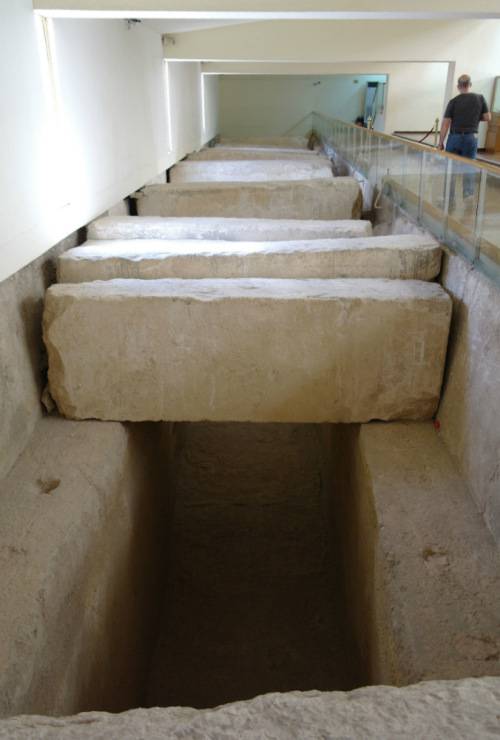
The “pit” in which the boat was buried. To date, the same repositories, both empty and with another rook, have been discovered.
On one of the stones, slightly rising above the rest, Mallah, the first to see the rook, noticed a hieroglyph meaning the name of the pharaoh “Djedephra”. Djedefra was the son of Cheops. The archaeologist suggested that under a layer of stones, perhaps, is a pit with a boat. Several excavated fragments of wood and rotten pieces of rope indicated that the ship had once been lying there. To verify the correctness of the hypothesis, it was necessary to have a few more objects or their fragments, and therefore the workers began to excavate more vigorously.
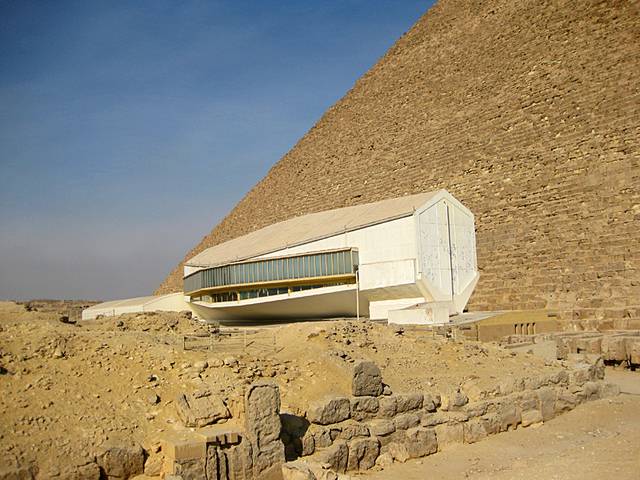
And here is the “resting place” of the Khufu boat - the “Museum of the Solar Boat”.
Towards noon, diggers were finally able to make a hole in the layer of stones. The noon sun shone so brightly that it dazzled his eyes, and Mallah saw absolutely nothing in that hole. In order to at least see something in the dark, I had to use a pocket mirror. Mallah sent a sunbeam into the hole and, glancing there, tried to look at something that snatched a ray of light from the pitch darkness. This “something” turned out to be the blades of a long rowing paddle. But before the blades, a thin, slightly perceptible, delightful fragrance of incense, whose age was almost five thousand years, broke loose. The brightest of them was the aroma of cedar wood, from the wood of which, according to scientists, the ship was built. It seems that Fortune turned its face to the seekers of artifacts!
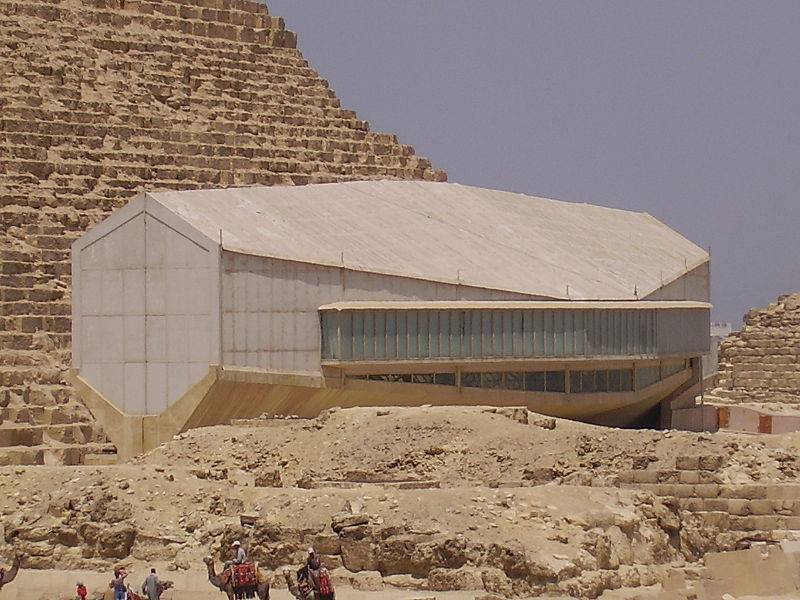
The construction of a completely unusual architecture, what to say!
A piece of onboard plating of the ship, which was taken to the chemical laboratory of the British Museum, was taken for examination. The laboratory confirmed that this is the cedar wood of the epoch of Cheops, which is also excellently preserved. Due to the fact that the pit was covered with stones and plastered with plaster, the tree was not exposed to external influences. Due to this, the ship lay in the ground for more than one thousand years and perfectly preserved. In order to keep such a unique discovery intact, a canopy was erected over the pit, then a crane was driven in. Work on the transport of stones stretched for two months.
After the ship was removed from the ground, it was transferred to the restorers. Here the first difficulties began to arise. The main restorer of Egyptian artifacts, Haj Ahmed Yousef Mustafa, had to deal with a number of problems that, in principle, were inevitable. The vessel consisted of several parts. And this “designer” had to be assembled. That's just a little detail prevented this: none of the scientists who worked there did not know at all in what order all this should be collected.
“There is a shadow here!”
Before assembling, each fragment should be photographed (or drawn) according to the rules, in as much detail as possible, from all sides. After all the fragments were painted on paper or photographed, it was allowed to extract them from the pit and immediately treat them with chemicals, since an unprocessed object that had lain in the earth for more than one thousand years could crumble into dust in an instant.
Unfortunately, Mustafa did not have special literature on the assembly of fragments of fossil objects. I had to rely on my own intuition. After making copies of all the 1224 parts at a certain scale, he enthusiastically set to work. The work was creative. After carefully studying the wall bas-reliefs on which the ancient Egyptian vessels were depicted, and examining the fragments of the vessel, they came to the conclusion that the boarding panels at that time were fastened together with a rope, several long pieces of which were found in the same pit. The technology of fastening the boards was magnificent in its simplicity: the rope was passed through a small hole, which was made in the board on its wide side, and it went out through the edge, due to which the rope was not visible from the outside. The know-how was amazing in its essence: it was as if the siding boards had been tied together to one another! And the lacing was very dense, according to the "requirements" of the construction of ships of those times. The ropes had to hold the boards firmly, so that they did not separate, and, moreover, the wood lining a priori should not let water through. That was the main rule of the “shipbuilders” of those times, and of today too.
As a result, the restoration work stretched as much as fourteen years, because at first no one really knew in what order and how the wooden parts of which the ship was made should be joined, and then fastened. Mustafa had to make five variants of the model of the vessel, before something suitable was found. The rebuilt ship had a length of over 43 meters, a width of almost 6 meters. The vessel's displacement was 45 tons. On the ship there were two cabins. Scientists have determined that the draft of the rook was 1,5 meters, this is a bit for the sea vessel, and from this the conclusion followed that the ship was intended to sail exclusively on the Nile. The movement of the rook should have been provided by five oarsmen, who had five pairs of oars at their disposal, different in length.
And this is how the pioneers worked on assembling the vessel.
The very fact of using the vessel for the passage along the Nile also did not cause any doubts. The fact is that on the mounting ropes traces of river silt were found, which eloquently testified that the ship was used specifically for river traffic, because there is only one river in Egypt.
There was one more circumstance in view of which the work on the reconstruction of the ship took so much time. The fact is that the design of the hull of the vessel is absolutely not similar to what we see today. Its essence is as follows: all present ships and even Viking rooks had a keel as their basis - a beam passing along the entire bottom of the vessel. Forms were attached to it - a kind of "ribs" of the hull, the contours of which define a specific profile of the vessel. Here was a completely unique case: the keel and frames were missing from the Solar boat of Cheops! Unbelievable, but it is a fact! And the ship was going to elementary: the board to the board, as if someone was folding a giant mosaic, of course, in a strictly defined sequence. From here it becomes clear the reason why it was so difficult for the Egyptians to decide to walk the sea over long distances: storms, powerful waves could instantly smash such a puzzle into pieces. And so the Egyptians invited the Phoenicians to sail around the African continent and, perhaps, they sailed this way using their ships, made, as is well known, from the very famous cedar tree that they mined in Lebanon.
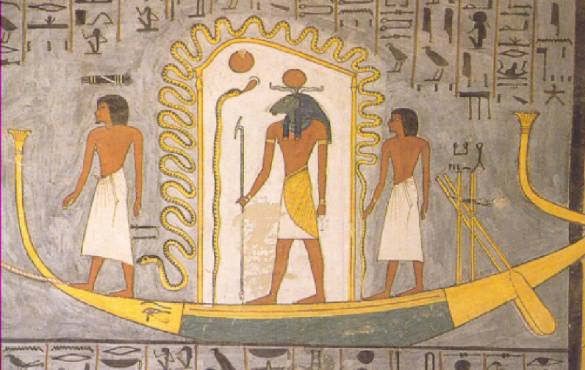
On such ships the gods of Egypt floated.
The ship of Cheops was intended, probably, as a ritual means of transporting the body of Pharaoh from Memphis to Giza. It was easier to transport it along the Nile, and therefore the vessel was dragged down the river in tow. And after the mummy of the son of the god Ra arrived at the place, the ship was immediately taken apart and buried.
It is worth noting that the Nile was and, by the way, remains for the Egyptians a river of "strategic importance", without which there would be no life in the hot sands of Egypt. This is a source of moisture for all living things, and the vehicle. That is why the ancient Egyptians Nile was considered a sacred river.
As the Nile flows from south to north, the Egyptians went downstream without a sail, and with a raised sail went up, against the current. It is curious that even in the writing of the Egyptians this found its reflection. The image of a boat with a sail mattered to “sail south”, and without a sail, “sail with the current” or “sail north”. The ancient Egyptians were firmly convinced that the god of the Sun, Ra, daily passes the heavenly path in his solar boat, and the Underworld also swims at night.
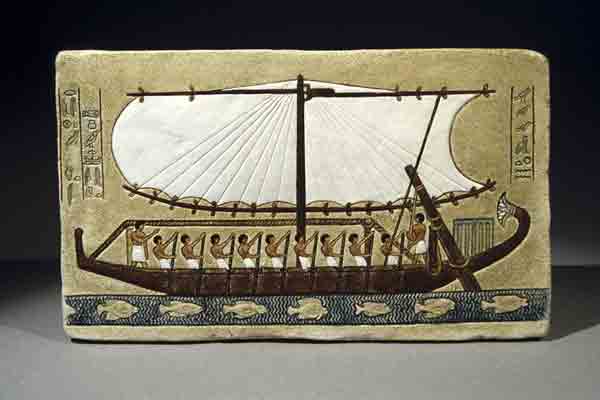
It looked like the Egyptian ships on which the Egyptians sailed to the country of Punt.
The restored ship has been perfectly preserved to this day. And so that the descendants could look at this miracle, the scientists did everything (and even more!) To keep it safe and sound. In the place where archaeologists found it, a special museum of original architecture was built. Every year it attracts a considerable number of tourists who come to Egypt to gaze at its wonders.
You will be in the Valley of the Pyramids, by all means go to this unusual museum. After all, the ship of Pharaoh, who found his refuge here, certainly deserves that every lover of antiquity would spend a little of his time to pay tribute to the memory of both Khufu and the ancient shipbuilders who built such an amazing vessel, which until today remains one of the most unusual monuments of the "era of the pharaohs".
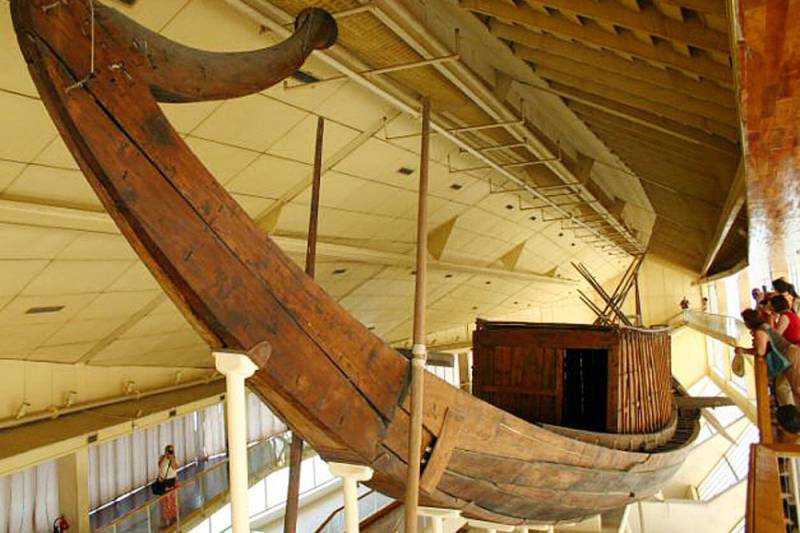
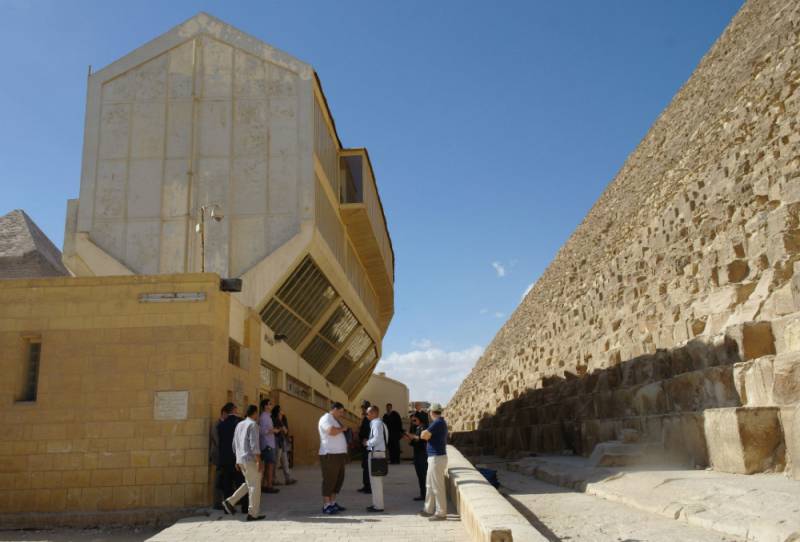
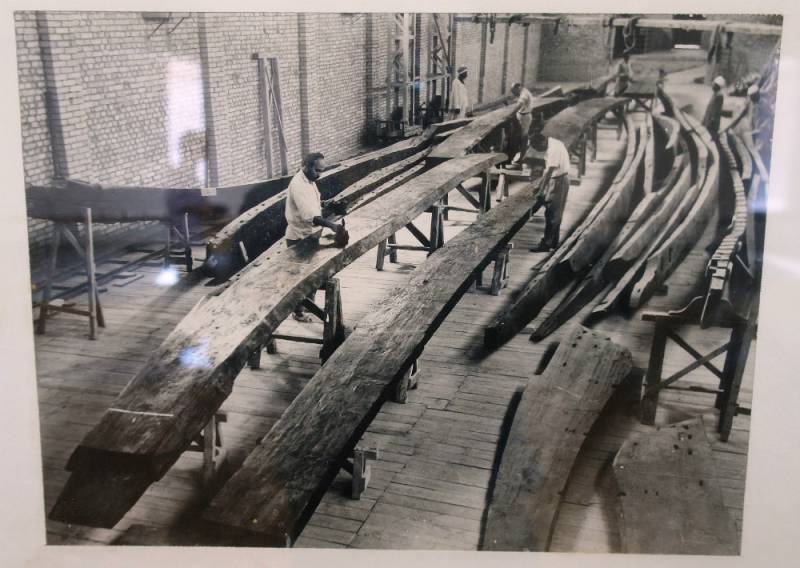
Information